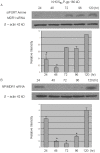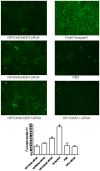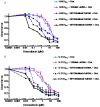Inhibition of ABCB1 (MDR1) expression by an siRNA nanoparticulate delivery system to overcome drug resistance in osteosarcoma
- PMID: 20520719
- PMCID: PMC2875382
- DOI: 10.1371/journal.pone.0010764
Inhibition of ABCB1 (MDR1) expression by an siRNA nanoparticulate delivery system to overcome drug resistance in osteosarcoma
Abstract
Background: The use of neo-adjuvant chemotherapy in treating osteosarcoma has improved patients' average 5 year survival rate from 20% to 70% in the past 30 years. However, for patients who progress after chemotherapy, its effectiveness diminishes due to the emergence of multi-drug resistance (MDR) after prolonged therapy.
Methodology/principal findings: In order to overcome both the dose-limiting side effects of conventional chemotherapeutic agents and the therapeutic failure resulting from MDR, we designed and evaluated a novel drug delivery system for MDR1 siRNA delivery. Novel biocompatible, lipid-modified dextran-based polymeric nanoparticles were used as the platform for MDR1 siRNA delivery; and the efficacy of combination therapy with this system was evaluated. In this study, multi-drug resistant osteosarcoma cell lines (KHOS(R2) and U-2OS(R2)) were treated with the MDR1 siRNA nanocarriers and MDR1 protein (P-gp) expression, drug retention, and immunofluoresence were analyzed. Combination therapy of the MDR1 siRNA loaded nanocarriers with increasing concentrations of doxorubicin was also analyzed. We observed that MDR1 siRNA loaded dextran nanoparticles efficiently suppresses P-gp expression in the drug resistant osteosarcoma cell lines. The results also demonstrated that this approach may be capable of reversing drug resistance by increasing the amount of drug accumulation in MDR cell lines.
Conclusions/significance: Lipid-modified dextran-based polymeric nanoparticles are a promising platform for siRNA delivery. Nanocarriers loaded with MDR1 siRNA are a potential treatment strategy for reversing MDR in osteosarcoma.
Conflict of interest statement
Figures







Similar articles
-
Lipid-functionalized dextran nanosystems to overcome multidrug resistance in cancer: a pilot study.Clin Orthop Relat Res. 2013 Mar;471(3):915-25. doi: 10.1007/s11999-012-2610-2. Clin Orthop Relat Res. 2013. PMID: 23011844 Free PMC article.
-
Gene/paclitaxel co-delivering nanocarriers prepared by framework-induced self-assembly for the inhibition of highly drug-resistant tumors.Acta Biomater. 2020 Feb;103:247-258. doi: 10.1016/j.actbio.2019.12.015. Epub 2019 Dec 14. Acta Biomater. 2020. PMID: 31846802
-
Doxorubicin loaded Polymeric Nanoparticulate Delivery System to overcome drug resistance in osteosarcoma.BMC Cancer. 2009 Nov 16;9:399. doi: 10.1186/1471-2407-9-399. BMC Cancer. 2009. PMID: 19917123 Free PMC article.
-
Targeting ABCB1 (MDR1) in multi-drug resistant osteosarcoma cells using the CRISPR-Cas9 system to reverse drug resistance.Oncotarget. 2016 Dec 13;7(50):83502-83513. doi: 10.18632/oncotarget.13148. Oncotarget. 2016. PMID: 27835872 Free PMC article. Review.
-
Structure, function and regulation of P-glycoprotein and its clinical relevance in drug disposition.Xenobiotica. 2008 Jul;38(7-8):802-32. doi: 10.1080/00498250701867889. Xenobiotica. 2008. PMID: 18668431 Review.
Cited by
-
Research progress on the multidrug resistance mechanisms of osteosarcoma chemotherapy and reversal.Tumour Biol. 2015 Mar;36(3):1329-38. doi: 10.1007/s13277-015-3181-0. Epub 2015 Feb 11. Tumour Biol. 2015. PMID: 25666750 Review.
-
In-Vitro and In-Vivo Establishment and Characterization of Bioluminescent Orthotopic Chemotherapy-Resistant Human Osteosarcoma Models in NSG Mice.Cancers (Basel). 2019 Jul 17;11(7):997. doi: 10.3390/cancers11070997. Cancers (Basel). 2019. PMID: 31319571 Free PMC article.
-
Adaptive mechanisms of resistance to anti-neoplastic agents.Medchemcomm. 2016 Oct 21;8(1):53-66. doi: 10.1039/c6md00394j. eCollection 2017 Jan 1. Medchemcomm. 2016. PMID: 30108690 Free PMC article. Review.
-
BPR1K653, a novel Aurora kinase inhibitor, exhibits potent anti-proliferative activity in MDR1 (P-gp170)-mediated multidrug-resistant cancer cells.PLoS One. 2011;6(8):e23485. doi: 10.1371/journal.pone.0023485. Epub 2011 Aug 24. PLoS One. 2011. PMID: 21887256 Free PMC article.
-
Strategies to gain novel Alzheimer's disease diagnostics and therapeutics using modulators of ABCA transporters.Free Neuropathol. 2021;2:33. doi: 10.17879/freeneuropathology-2021-3528. Epub 2021 Dec 13. Free Neuropathol. 2021. PMID: 34977908 Free PMC article.
References
-
- Lourda M, Trougakos IP, Gonos ES. Development of resistance to chemotherapeutic drugs in human osteosarcoma cell lines largely depends on up-regulation of Clusterin/Apolipoprotein J. Int J Cancer. 2007;120:611–622. - PubMed
-
- Fletcher CDM, Unni KK, Mertens F. IARC Press: Lyon; 2002. World Health Organization Classification of Tumours: Pathology and Genetics of Tumours of Soft Tissue and Bone.
-
- Schwartz CL, Gorlick R, Teot L, Krailo M, Chen Z, et al. Multiple drug resistance in osteogenic sarcoma: INT0133 from the Children's Oncology Group. J Clin Oncol. 2007;25:2057–2062. - PubMed
-
- Chou AJ, Gorlick R. Chemotherapy resistance in osteosarcoma: current challenges and future directions. Expert Rev Anticancer Ther. 2006;6:1075–1085. - PubMed
-
- Dean M, Fojo T, Bates S. Tumour stem cells and drug resistance. Nat Rev Cancer. 2005;5:275–284. - PubMed
Publication types
MeSH terms
Substances
Grants and funding
LinkOut - more resources
Full Text Sources
Miscellaneous

